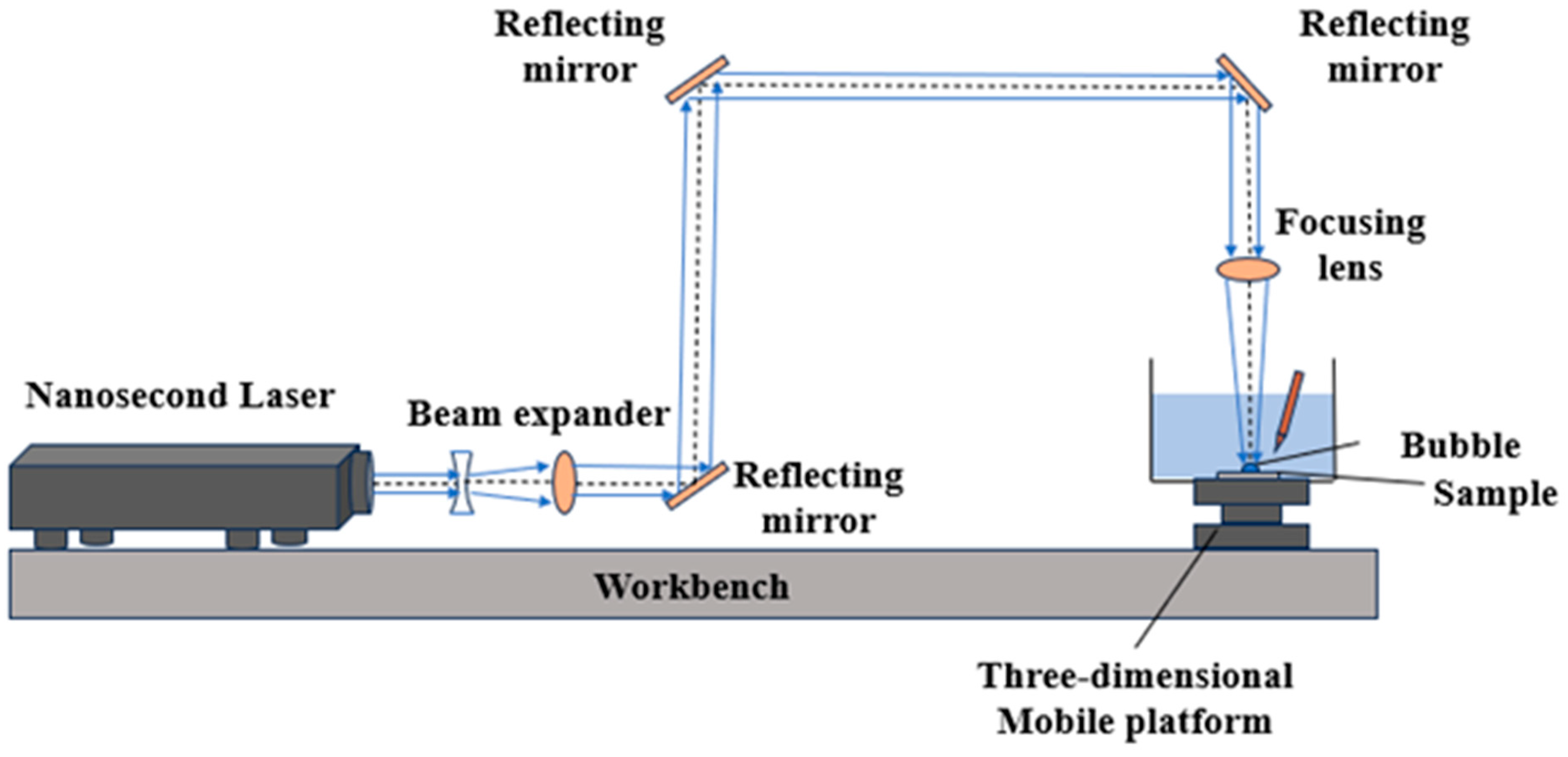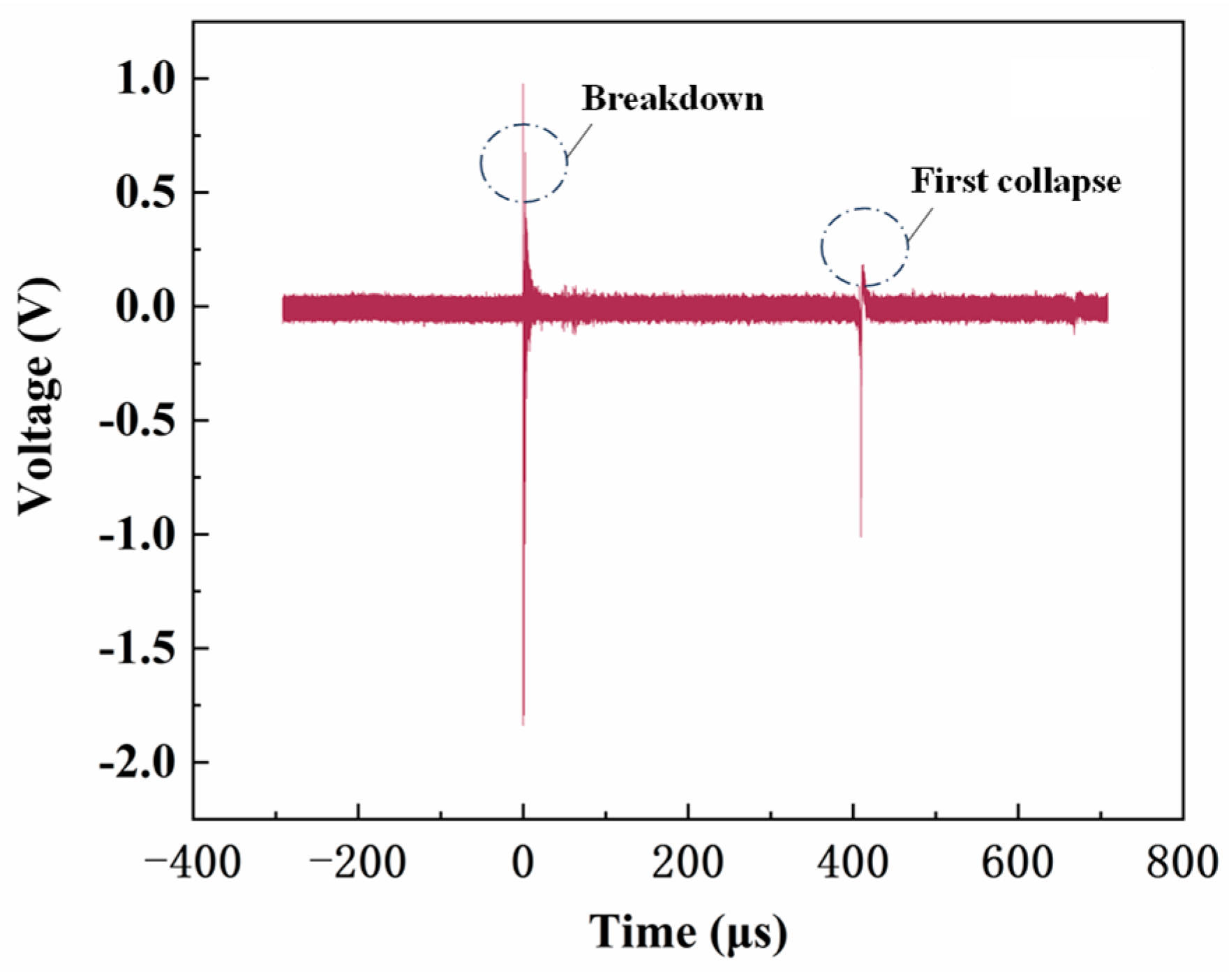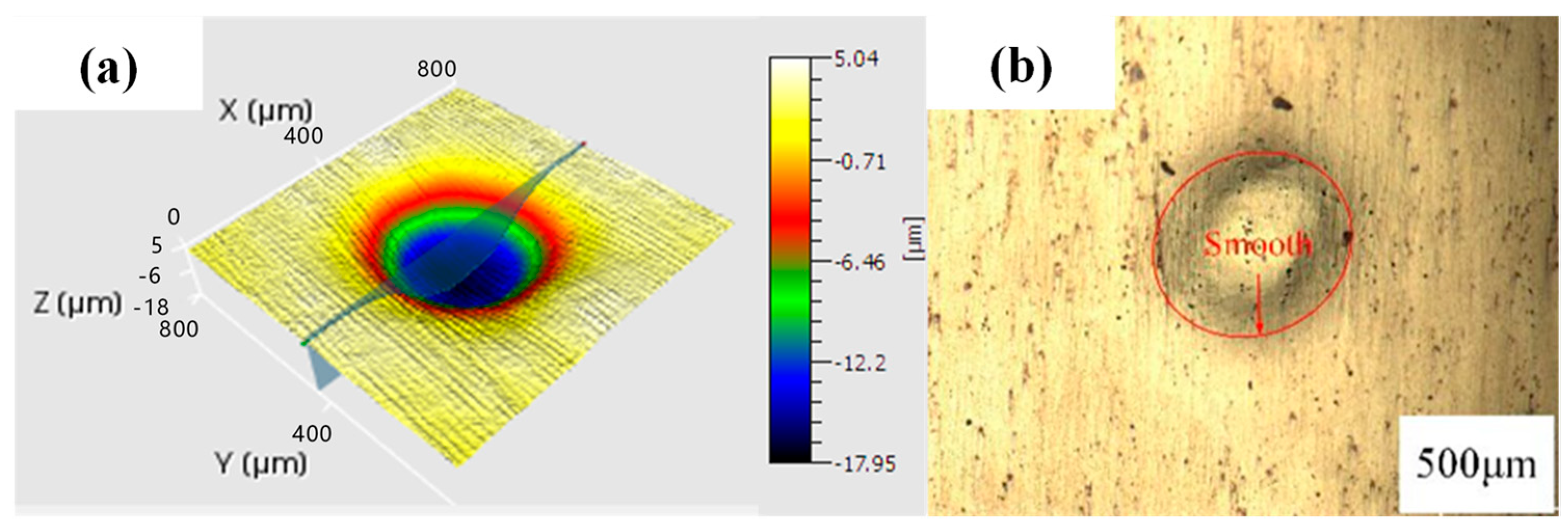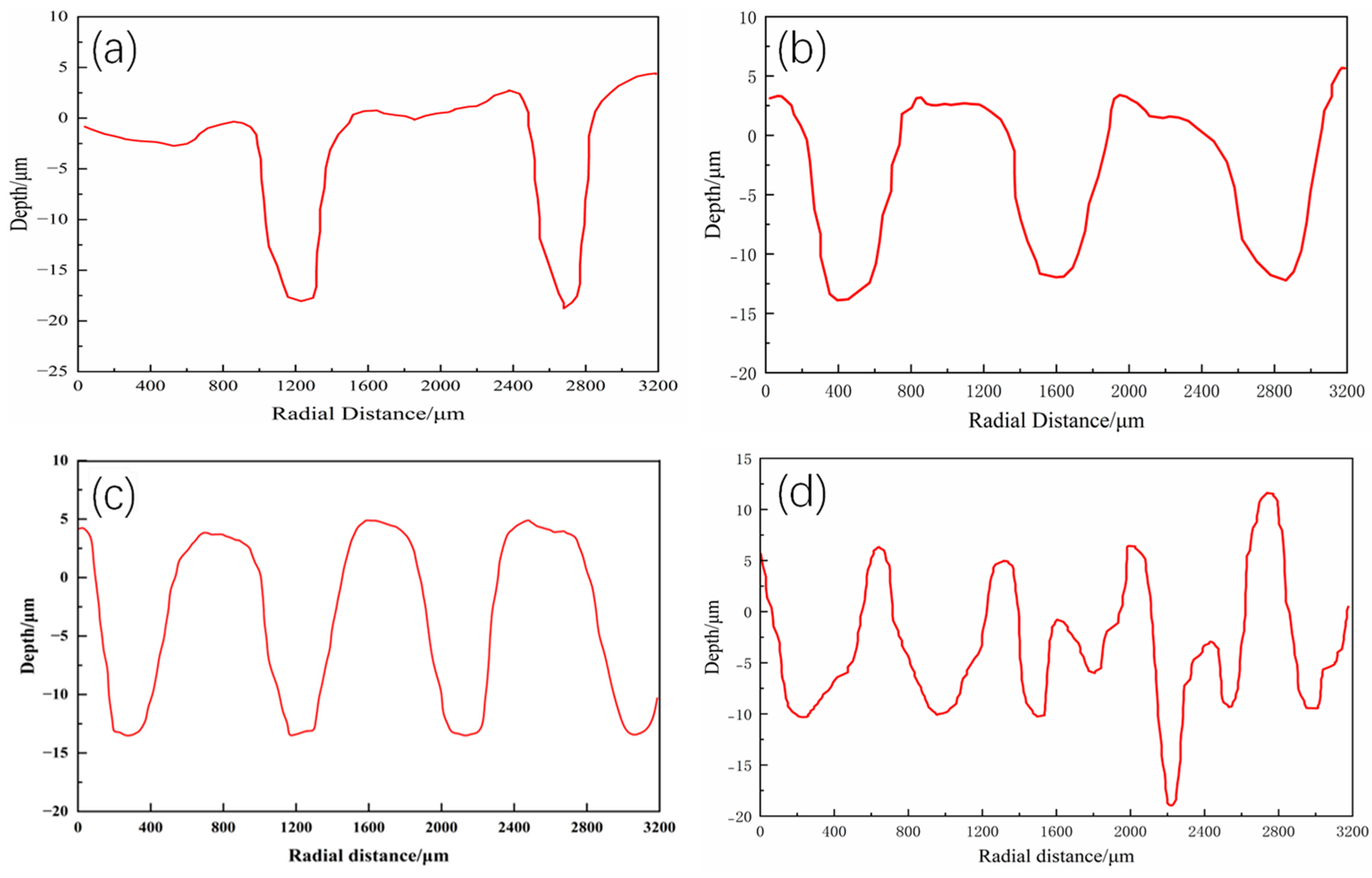Experimental Study of Surface Microtexture Formed by Laser-Induced Cavitation Bubble on 7050 Aluminum Alloy
Abstract
1. Introduction
2. Materials and Methods
- (1)
- Sample preparation
- (2)
- Laser-induced cavitation bubble microtexture platform
- (3)
- Testing equipment
- (4)
- Test procedure
3. Discussion and Analysis
3.1. Feasibility Study on Formation of Micropit by Laser-Induced Cavitation Bubble
3.2. Study on Surface Morphology of Microtexture Formed by Laser-Induced Cavitation Bubble
3.3. Study on Friction and Wear Properties of Microtexture Formed by Laser-Induced Vacuuming
4. Conclusions
Author Contributions
Funding
Institutional Review Board Statement
Informed Consent Statement
Data Availability Statement
Conflicts of Interest
References
- Zhang, Z.; Wei, S.; Wang, P.; Qiu, W.; Zhang, G. Progress in applications of laser induced cavitation on surface processing. Opt. Laser Technol. 2024, 170, 110212. [Google Scholar] [CrossRef]
- Wee, L.M.; Ng, E.Y.K.; Prathama, A.H.; Zheng, H. Micro-machining of silicon wafer in air and under water. Opt. Laser Technol. 2011, 43, 62–71. [Google Scholar] [CrossRef]
- Bao, J.; Long, Y.; Tong, Y.; Yang, X.; Zhang, B.; Zhou, Z. Experiment and simulation study of laser dicing silicon with water-jet. Appl. Surf. Sci. 2016, 387, 491–496. [Google Scholar] [CrossRef]
- Zhou, R.; Li, K.; Cao, Y.; Shi, W.; Yang, Y.; Tan, L.; Hu, R.; Jin, Y. Experimental Study of Laser induced Cavitation Bubble near Wall: Plasma Shielding Observation. Water 2024, 16, 1324. [Google Scholar] [CrossRef]
- Nath, A.; Keare, A. Measurement of charged particles and cavitation bubble expansion velocities in laser induced breakdown in water. Laser Part. Beams 2008, 26, 425–432. [Google Scholar] [CrossRef]
- Klaseboer, E.; Fong, S.W.; Turangan, C.K.; Khoo, B.C.; Szeri, A.J.; Calvisi, M.L. Interaction of lithotripter shockwaves with single inertial cavitation bubble. J. Fluid Mech. 2007, 593, 33–56. [Google Scholar] [CrossRef]
- Lai, G.; Geng, S.; Zheng, H.; Yao, Z.; Zhong, Q.; Wang, F. Early Dynamics of a Laser induced Underwater Shock Wave. J. Fluids Eng.-Trans. ASME 2022, 144, 011501. [Google Scholar] [CrossRef]
- Wen, H.; Yao, Z.; Zhong, Q.; Tian, Y.; Sun, Y.; Wang, F. Energy partitioning in laser induced millimeter-sized spherical cavitation up to the fourth oscillation. Ultrason. Sonochem. 2023, 95, 106391. [Google Scholar] [CrossRef]
- Brujan, E.-A.; Vogel, A. Stress wave emission and cavitation bubble dynamics by nanosecond optical breakdown in a tissue phantom. J. Fluid Mech. 2006, 558, 281, Erratum in J. Fluid Mech. 2008, 608, 411. [Google Scholar] [CrossRef]
- Sankin, G.N.; Yuan, F.; Zhong, P. Pulsating Tandem Microbubble for Localized and Directional Single-Cell Membrane Poration. Phys. Rev. Lett. 2010, 105, 078101. [Google Scholar] [CrossRef]
- Sinibaldi, G.; Occhicone, A.; Pereira, F.A.; Caprini, D.; Marino, L.; Michelotti, F.; Casciola, C.M. Laser induced cavitation: Plasma generation and breakdown shockwave. Phys. Fluids 2019, 31, 103302. [Google Scholar] [CrossRef]
- Chichkov, B.N.; Momma, C.; Nolte, S.; Von Alvensleben, F.; Tünnermann, A. Femtosecond, picosecond and nanosecond laser ablation of solid. Appl. Phys. A 1996, 63, 109–115. [Google Scholar] [CrossRef]
- Mao, B.; Li, B.; Lin, D.; Liao, Y. Enhanced room temperature-stretch formability of AZ31B magnesium alloy sheet by laser shock peening. Mater. Sci. Eng. A 2019, 756, 219–225. [Google Scholar] [CrossRef]
- Wang, L.; Guo, Z.; Deng, Y.; Chen, T.; Xie, M.; Xiao, Y.; Zou, Z. Experimental research into microgroove stamping by laser induced cavitation. Opt. Laser Technol. 2022, 146, 107549. [Google Scholar] [CrossRef]
- Cao, Y.; Hu, R.; Shi, W.; Zhou, R. Experimental Study on Near-Wall Laser induced Cavitation Bubble Micro-Dimple Formation on 7050 Aluminum Alloy. Water 2024, 16, 1410. [Google Scholar] [CrossRef]
- Ren, X.D.; He, H.; Tong, Y.Q.; Ren, Y.P.; Yuan, S.Q.; Liu, R.; Wang, D.S. Experimental investigation on dynamic characteristics and strengthening mechanism of laser induced cavitation bubble. Ultrason. Sonochem. 2016, 32, 218–223. [Google Scholar] [CrossRef]
- Tzanakis, I.; Eskin, D.G.; Georgoulas, A.; Fytanidis, D.K. Incubation pit analysis and calculation of the hydrodynamic impact pressure from the implosion of an acoustic cavitation bubble. Ultrason. Sonochem. 2014, 21, 866–878. [Google Scholar] [CrossRef]
- Long, J.; Eliceiri, M.H.; Ouyang, Y.; Zhang, Y.; Xie, X.; Grigoropoulos, C.P. Effects of immersion depth on the dynamics of cavitation bubble generated during ns laser ablation of submerged targets. Opt. Lasers Eng. 2021, 137, 106334. [Google Scholar] [CrossRef]
- Long, J.; Eliceiri, M.H.; Wang, L.; Vangelatos, Z.; Ouyang, Y.; Xie, X.; Zhang, Y.; Grigoropoulos, C.P. Capturing the final stage of the collapse of cavitation bubble generated during nanosecond laser ablation of submerged targets. Opt. Laser Technol. 2021, 134, 106647. [Google Scholar] [CrossRef]
- Soyama, H.; Kikuchi, T.; Nishikawa, M.; Takakuwa, O. Introduction of compressive residual stress into stainless steel by employing a cavitating jet in air. Surf. Coat. Technol. 2011, 205, 3167–3174. [Google Scholar] [CrossRef]
- Zhang, H.; Ren, X.; Tong, Y.; Larson, E.A.; Adu-Gyamfi, S.; Wang, J.; Li, X. Surface integrity of 2A70 aluminum alloy processed by laser induced peening and cavitation bubble. Results Phys. 2019, 12, 1204–1211. [Google Scholar] [CrossRef]
- Gu, J.; Liu, H.; Luo, Z.; Liu, A.; Ren, X. Laser cavitation processing of mild steel: Surface integrity, microstructure and stress corrosion performance. Mater. Today Commun. 2023, 35, 105464. [Google Scholar] [CrossRef]
- Takada, N.; Nakano, T.; Sasaki, K. Formation of cavitation-induced pits on target surface in liquid-phase laser ablation. Appl. Phys. A-Mater. Sci. Process. 2010, 101, 255–258. [Google Scholar] [CrossRef]
- Wang, L.; Deng, Y.; Zou, Z.; Xiao, Y.; Su, G.; Guo, Z. The forming of microgroove in copper foil on multiple laser induced cavitation impacts. J. Manuf. Process. 2022, 78, 82–91. [Google Scholar] [CrossRef]
- Wang, L.; Deng, Y.; Zou, Z.; Xiao, Y.; Su, G.; Guo, Z. Microgroove formation in thin copper by laser induced cavitation bubble shock: Numerical and experimental investigation. Appl. Opt. 2022, 61, 1841–1850. [Google Scholar] [CrossRef] [PubMed]
- Zhang, Z.; Zhang, Y.; Liu, D.; Zhang, Y.; Zhao, J.; Zhang, G. Bubble Behavior and Its Effect on Surface Integrity in Laser induced Plasma Micro-Machining Silicon Wafer. J. Manuf. Sci. Eng.-Trans. ASME 2022, 144, 091008. [Google Scholar] [CrossRef]
- Ye, Y.; Wu, M.; Ren, X.; Zhou, J.; Li, L. Hole-like surface morphologies on the stainless steel surface through laser surface texturing underwater. Appl. Surf. Sci. 2018, 462, 847–855. [Google Scholar] [CrossRef]
- Lu, Z.; Gu, J.; Zhang, P.; Luo, C.; Ren, X. Investigation on laser cavitation micro-forming process: Deformation behavior of 1060 aluminum foil and bubble evolution in a gap. J. Manuf. Process. 2021, 67, 619–627. [Google Scholar] [CrossRef]
- Cao, Y.; Hu, R.; Shi, W.; Wang, Z.; Qiu, M.; Zhang, X.; Li, B. Experimental study on laser peen texturing and tribological properties of E690 high-strength steel. Opt. Laser Technol. 2023, 157, 108784. [Google Scholar] [CrossRef]
- Zhang, J.; Wu, C.; Shi, X.; Xue, Y.; Huang, Q.; Zhang, K. Tribological Properties and Frictional Noise Behavior of Inconel 625 with Microtexture Filled by Sn-Ag-Cu. J. Mater. Eng. Perform. 2022, 31, 82–93. [Google Scholar] [CrossRef]
- Yang, X.; Fu, Y.; Ji, J.; Chen, T.; Pan, C. Study on tribological properties of surface concave convex microtexture on the mold steel. Ind. Lubr. Tribol. 2020, 72, 1167–1171. [Google Scholar] [CrossRef]












| Density | Modulus of Elasticity | Poisson’s Ratio | Yield Strength | Tensile Strength |
|---|---|---|---|---|
| 2780/(kg·m−3) | 72 GPa | 0.33 | 435.7 MPa | 534.624 MPa |
| Test Parameter Value | Numerical Value |
|---|---|
| Frequency (Hz) | 2 |
| Load (N) | 8 |
| Time (s) | 600 |
| Room temperature (°C) | 8 |
| Travel (mm) | 25 |
| Test Parameter Value | Numerical Value |
|---|---|
| Wave length (nm) | 1064 |
| Pulse width (ns) | 9 |
| Frequency (Hz) | 5 |
| Spot diameter (mm) | 0.5 |
| Energy (mJ) | 400 |
| Number of shocks | 1 |
| Test Number | Density of Microtexture |
|---|---|
| 1 | 0% |
| 2 | 8.72% |
| 3 | 12.56% |
| 4 | 19.63% |
| 5 | 34.88% |
Disclaimer/Publisher’s Note: The statements, opinions and data contained in all publications are solely those of the individual author(s) and contributor(s) and not of MDPI and/or the editor(s). MDPI and/or the editor(s) disclaim responsibility for any injury to people or property resulting from any ideas, methods, instructions or products referred to in the content. |
© 2024 by the authors. Licensee MDPI, Basel, Switzerland. This article is an open access article distributed under the terms and conditions of the Creative Commons Attribution (CC BY) license (https://creativecommons.org/licenses/by/4.0/).
Share and Cite
Li, B.; Min, B.-W.; Ma, Y.; Zhou, R.; Gu, H.; Cao, Y. Experimental Study of Surface Microtexture Formed by Laser-Induced Cavitation Bubble on 7050 Aluminum Alloy. Coatings 2024, 14, 1230. https://doi.org/10.3390/coatings14091230
Li B, Min B-W, Ma Y, Zhou R, Gu H, Cao Y. Experimental Study of Surface Microtexture Formed by Laser-Induced Cavitation Bubble on 7050 Aluminum Alloy. Coatings. 2024; 14(9):1230. https://doi.org/10.3390/coatings14091230
Chicago/Turabian StyleLi, Bin, Byung-Won Min, Yingxian Ma, Rui Zhou, Hai Gu, and Yupeng Cao. 2024. "Experimental Study of Surface Microtexture Formed by Laser-Induced Cavitation Bubble on 7050 Aluminum Alloy" Coatings 14, no. 9: 1230. https://doi.org/10.3390/coatings14091230
APA StyleLi, B., Min, B.-W., Ma, Y., Zhou, R., Gu, H., & Cao, Y. (2024). Experimental Study of Surface Microtexture Formed by Laser-Induced Cavitation Bubble on 7050 Aluminum Alloy. Coatings, 14(9), 1230. https://doi.org/10.3390/coatings14091230






